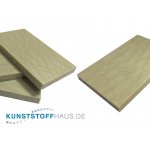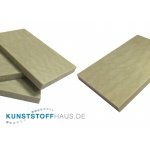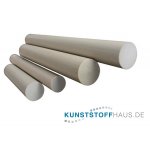PEEK, a high-performance material for a variety of requirements
Polyether ether ketone (PEEK) is a very wear-resistant and dimensionally stable material that meets the highest requirements in terms of continuous operating temperatures of up to 260°C, sliding and wear behaviour, chemical resistance, fire behaviour and its resistance to radiation. In addition, it has excellent sliding properties even under strong thermal stress.
Due to these properties, PEEK is often used at high mechanical loads and operating temperatures. Other areas of application for this material include chemical process engineering, medical technology and the aerospace industry.
PEEK - Polyetheretherketone
PEEK plastic is a high-performance plastic that is used in many areas of industry. In addition to the automotive and food industries, the medical and electrical engineering sectors and the aviation industry are among the main customers. In electrical engineering, the material is also used in the insulation of electric motors. Here, slot insulations and deck slides are then manufactured from PEEK.
The PEEK material is extremely heat-resistant, resistant to bending and tension, even when exposed to hot water or steam.
PEEK is an expensive product, but the thermoplastic offers advantages: Components made of PEEK plastic are not only light and strong, they can also withstand extreme operating conditions over a long period of time. All in all, it can make sense to rely on PEEK. Many other materials do not work in applications where PEEK can be used.
PEEK properties compared to other thermoplastics
Compared to other thermoplastics, PEEK plastic melts at a very high temperature of 335 degrees Celsius and is then formed by extruder or injection molding. PEEK films can also be produced. As soon as it has hardened again, the PEEK can then be machined, for example with a milling machine. This produces PEEK round rods, hollow rods or sheets with the following properties:
- Extremely temperature-resistant (up to 260 degrees Celsius)
- High chemical resistance
- Radiation resistant
- Abrasion and wear resistant
- Hardly toxic and smoke emissions
- Hydrolysis resistant up to about 280 degrees Celsius
PEEK material is solid and has a density of approximately 1.32 and a thermal conductivity of 0.25 W/mK. In its original state it has a brown-grey-yellowish colour, but as an industrial material it is also available in various colours. PEEK is also available in blue, green and black.
Possible applications of PEEK Material
The plastic PEEK offers advantages that not only plastic professionals appreciate. Its properties such as creep resistance, resistance to hot steam or electrical insulation make PEEK a popular material that can be used in a wide variety of applications.
Gear wheels made of PEEK, PEEK metering pistons, seals and sliding strips made of PEEK are just a few examples of how polyether ether ketone can be further processed. PEEK not only withstands mechanical stress to a high degree, but is also extremely resistant to thermal stress. PEEK can withstand exceptionally high temperatures as well as tension or pressure without losing its shape. PEEK material is used in these areas:
- Automotive industry (for example pistons, seals)
- Aerospace industry (seals and flaps)
- Insulation of power supply cables in crude oil production
- Insulating material in high voltage engineering
- Slot insulation and deck slides in the production of electric motors
- Medical technology in devices, as handle, as membrane foils
- Pharmaceutical industry (especially for parts in contact with the product in production plants)
- Food industry Chemical industry (in all areas where high thermal, mechanical and chemical resistance is required)
- Dental technology (implants as well as frameworks for dentures)
- Semiconductor technology (wafer carriers)
- Core material for instrument and tennis strings
Processing of PEEK
Polyetheretherketone is formed when bisphenol salts are alkylated. It is a high-performance thermoplastic that liquefies at high temperatures and can then be formed into any desired shape by extruder or injection moulding.
Further processing of PEEK
CNC milling from PEEK
CNC milling from PEEK offers a wide range of advantages:
- Manufacture of the most complex workpieces from PEEK possible
- Highest precision and production speed throughout the entire process
- Significant reduction of set-up times
- Several work steps with one clamping - the time-consuming reclamping of workpieces is no longer necessary
- Consistently high production quality and repeatability
- Ideal for the production of workpieces in large series
CNC milling of PEEK allows the production of a wide variety of parts and semi-finished products in large quantities that would be impossible or extremely time-consuming to produce using other methods. Since the production quality and dimensional compliance during the milling process always remain at a constantly high level, human error - for example, due to inadequate compliance with dimensions and tolerances - can be virtually eliminated, thus keeping scrap to a minimum.
This not only saves further costs but also a lot of time. This also applies to tool changes, which modern CNC milling machines perform automatically when the milling program is run. Last but not least, the milling cutters used can be guided and moved much faster by machine than by the hand of a machine operator. Last but not least, the unlimited repeatability of a program is a great advantage in CNC milling, as it can be used as often as required. Other variants of the workpiece can be produced by making slight changes to the CNC program.
There is hardly a contour that could not be achieved with a CNC milling machine. Thus, in addition to rotationally symmetrical or cuboidal workpieces, 3D free-form surfaces or complex parts such as gears made of PEEK or PEEK implants can be produced. The desired contour of the workpiece is determined by both the feed rate and the shape of the milling cutter, for example by using different cutter shapes.
Punching of PEEK
PEEK can be punched with the usual punching processes. This enables the production of medium to large quantities. One common product is PEEK washers, which are manufactured in large quantities.
Water jet cutting of PEEK
In water jet cutting, PEEK is separated by a high-pressure water jet. This jet has a pressure of up to 6000 bar and reaches discharge speeds of up to 1000 m/s. Despite this immense performance, PEEK hardly heats up at all.
There is no heat development. With this cold cutting process, no structural changes, edge zone hardening or microcracks occur in the cutting area. High cutting quality: The surface roughness can be regulated with the feed rate depending on the requirements.
Cutting qualities of N8 - N12 are common. The cutting angle error is 0-2°, depending on the hardness and thickness of the material. This is reduced by reducing the speed. With the fine beam of 0.8mm diameter, simple to highly complex geometries can be cut precisely. In most cases, tolerances of the average free size tolerance field can be maintained. Optically relevant parts can be cut with protective foil and thus obtain an excellent cut quality.
Processing notes for PEEK
Under the following link you will find our processing instructions for PEEK.
Modifications of PEEK
In addition to the unfilled PEEK polymer, other modifications are also available:
- PEEK with 30 percent glass reinforcement
- PEEK in combination with carbon fibres (ratio 70 to 30)
- PEEK with powerful additives for storage and against wear
- PEEK with mineral filling
- PEEK with electrically conductive additives
- PEEK with ceramic filling
PEEK plates
You can obtain our PEEK sheets from us in a wide range of thicknesses and dimensions.
Glass fibre reinforced PEEK plates are also available in our shop at short notice.
PEEK rods
PEEK rods are also available in a wide range of dimensions.


